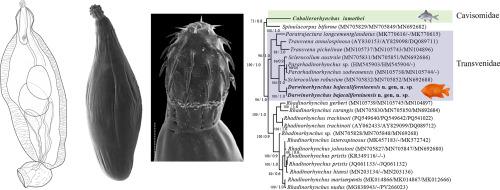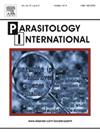Morphological and molecular data reveal a new genus and species from the family Transvenidae (Echinorhynchida: Palaeacanthocephala) from Bahía de Todos los Santos, Northeast Pacific, Mexico
IF 1.9
4区 医学
Q3 PARASITOLOGY
引用次数: 0
Abstract
Echinorhynchids are a group of globally distributed acanthocephalan parasites mainly of freshwater, brackish and marine fishes and occasionally, reptiles and amphibians. During several parasitology surveys in the Gulf of Mexico and Northeast Pacific, Mexico, acanthocephalans were recovered from two marine fish species. The specimens from the Gulf of Mexico were identified as Caballerorhynchus lamothei (Cavisomidae), a typical parasite of the striped mojarra, whereas adult acanthocephalans from the Northeast Pacific, Mexico, from the Garibaldi fish exhibited morphological characteristics belonging to the family Transvenidae. Sequences from the small (SSU) and large (LSU) subunits of ribosomal DNA and cytochrome c oxidase subunit 1 (cox 1) of mitochondrial DNA were obtained for both species. The new sequences were aligned with other sequences available in the GenBank dataset from Echinorhynchida. Phylogenetic trees inferred with the combined (SSU + LSU), concatenated (SSU + LSU+ cox 1), and cox 1 datasets consistently placed the two species into two independent lineages. The species C. lamothei from Cavisomidae was placed in a clade together with members from Spinulacorpidae, Rhadinorhynchidae and Transvenidae, suggesting that Cavisomidae is paraphyletic. The unidentified specimens were nested inside a clade formed by members of Transvenidae. Morphologically, the new samples presented a combination of unique diagnostic traits, which was not observed in other members of the Transvenidae family. Therefore, the genus Darwinorhynchus was created to accommodate a new species named herein as Darwinorhynchus bajacaliforniaensis n. gen., n. sp. The current record from a transvenid acanthocephalan expands its distribution range to the northern Pacific in the Americas, Indian Ocean and Arabian Gulf.

在墨西哥东北太平洋Bahía de Todos los Santos发现Transvenidae科(Echinorhynchida: Palaeacanthocephala)一新属和新种
棘球绦虫是一种分布于全球的棘头类寄生虫,主要寄生于淡水、咸淡鱼和海洋鱼类,偶尔也寄生于爬行动物和两栖动物。在墨西哥湾和墨西哥东北太平洋的几次寄生虫学调查中,从两种海鱼中发现了棘头类。来自墨西哥湾的棘头鱼标本被鉴定为条纹鱼的典型寄生虫Caballerorhynchus lamothei (Cavisomidae),而来自墨西哥东北太平洋的加里波第鱼(Garibaldi fish)的棘头鱼成虫的形态特征属于Transvenidae科。从两个物种的核糖体DNA的小亚基(SSU)和大亚基(LSU)以及线粒体DNA的细胞色素c氧化酶亚基1 (cox 1)中获得序列。新序列与来自Echinorhynchida的GenBank数据集中的其他序列进行了比对。用组合(SSU + LSU)、串联(SSU + LSU+ cox 1)和cox 1数据集推断的系统发育树一致地将这两个物种置于两个独立的谱系中。家鼠科的家鼠与棘足科、鼠足科和Transvenidae的成员被放在一个分支中,表明家鼠科是附生的。这些身份不明的标本被嵌套在一个由Transvenidae成员组成的分支中。形态学上,新样本呈现出独特的诊断特征组合,这在其他Transvenidae家族成员中没有观察到。因此,Darwinorhynchus属的创建是为了容纳一个新物种,本文将其命名为Darwinorhynchus bajacaliforniaensis n. gen., n. sp.。目前记录的跨venid棘头虫将其分布范围扩大到北太平洋、美洲、印度洋和阿拉伯湾。
本文章由计算机程序翻译,如有差异,请以英文原文为准。
求助全文
约1分钟内获得全文
求助全文
来源期刊

Parasitology International
医学-寄生虫学
CiteScore
4.00
自引率
10.50%
发文量
140
审稿时长
61 days
期刊介绍:
Parasitology International provides a medium for rapid, carefully reviewed publications in the field of human and animal parasitology. Original papers, rapid communications, and original case reports from all geographical areas and covering all parasitological disciplines, including structure, immunology, cell biology, biochemistry, molecular biology, and systematics, may be submitted. Reviews on recent developments are invited regularly, but suggestions in this respect are welcome. Letters to the Editor commenting on any aspect of the Journal are also welcome.
 求助内容:
求助内容: 应助结果提醒方式:
应助结果提醒方式:


